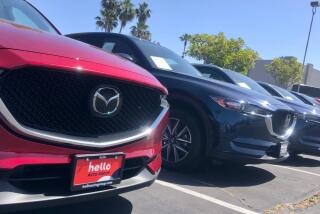Auto Makers Take Steps to Protect Pedestrians
- Share via
The rising incidence of car versus pedestrian accidents in Los Angeles (Your Wheels, Feb. 6) prompted reader Charles Hiigel of San Luis Obispo to wonder what, if anything, auto makers are doing to improve the chances of those on foot surviving a collision with a car or truck.
Auto makers long have been researching ways to make vehicles more pedestrian-friendly, and a few have added features to help reduce injuries to the pedestrian in a vehicle versus walker collision.
But overall, making cars safer for pedestrians has not been a high priority, especially in the United States, auto industry officials and safety advocates agree.
The auto industry has been talking for years about items like exterior air bags and redesigned hoods that would reduce pedestrian injuries, but there’s been very little initiative to incorporate the technology in today’s vehicles, said Clarence Ditlow, executive director of the Center for Auto Safety in Washington.
“It’s not that the technology isn’t there. These safety features are known lifesavers,” Ditlow said. “[But] unless government is willing to set regulations, auto makers are not likely to voluntarily offer them,” he says.
Though pedestrian fatalities and injuries are of concern in the United States, the problem is much more serious in other countries.
There were 5,000 pedestrian fatalities in the U.S. in 1999. Nearly 7,000 pedestrians were killed the same year in Western Europe, while Japan reported 3,000 pedestrian deaths.
To help curb deaths and injuries, auto makers have given the European Union a voluntary commitment to improve vehicle designs for pedestrian safety.
Under the agreement, auto makers will implement new safety measures this year that will include redesigning vehicle front ends, abolishing so-called cow bars (brush guards in the U.S.) and introducing anti-lock braking systems on all cars.
In the U.S., Honda has introduced a redesigned hood on some late-model Civics and CRVs to provide a softer crumple zone--the sheet metal isn’t as rigid--to reduce pedestrian head injuries during an accident. The auto maker also has readjusted window wipers to make the windshield area less dangerous to pedestrians if they are hit and thrown onto the hood, according to Greg Thomas, a senior engineer with Honda’s research and development department.
And Ford Motor Co. has been testing the use of exterior air bags as a way to reduce pedestrian injuries, said Sara Tatchio, a Ford spokeswoman.
In a concept pedestrian safety car developed in 2000, Ford outfitted an Explorer SUV with a pair of exterior air bags designed to protect pedestrians in an accident.
The system is designed to provide head protection when a pedestrian is thrown over the hood toward the base of the windshield. The air bags extend along the windshield base from the center line to the A-pillars and are triggered by a sensor that detects when a pedestrian is hit by the bumper.
When inflated, the bags would cover the full width of the vehicle along the windshield base, protecting a pedestrian from being injured by hard windshield wiper spindles, hood mounts and the lower part of the windshield glass.
Ford also tested an over-the-hood air bag that deploys from just above the bumper and is activated just before impact by a sensor. The inflated airbag is about 54 inches wide, 22 inches high and 5 inches thick and spans the area between the headlamps and extends from the top of the bumper to several inches above the hood surface.
Despite the research, there are no current plans to install these air-bag systems in Ford vehicles in the U.S., Tatchio said. And although pedestrian-friendly safety features will be implemented in coming years, European consumers will see them first, she said.
Ford and other car makers also have been working on pedestrian-sensing and warning technologies aimed at helping to prevent vehicles from hitting pedestrians.
In December, General Motors petitioned the National Highway Traffic Safety Administration to require that all domestically manufactured vehicles be equipped with daylight running lights (DRLs).
They are reduced-intensity lights on the front of vehicles that automatically illuminate when the vehicle is started. They make the vehicles easier to see by both other drivers and pedestrians, says GM spokesman Jay Cooney.
“They make a vehicle look closer than it actually is,” he says. “Pedestrians, consequently, have more time to react.”
GM started phasing-in DRLs in 1996 and now all of its vehicles have them--they are, Cooney says, a “very cost-effective crash-avoidance system.” A study by NHTSA, released in 2000, found that DRLs reduced fatal car-pedestrian crashes by 28%, Cooney says.
GM also has begun using a night-vision system--so far available only on Cadillacs--enhances the driver’s ability to see in the dark. With it, drivers get an early warning that a pedestrian is in the road up ahead, Cooney says.
There are many critical safety issues that face auto makers today. But any technology that can protect pedestrians from serious injuries and death will be welcomed--especially when you consider the Insurance Institute for Highway Safety’s finding that children under 16 are the pedestrians most likely to be struck by motor vehicles.
*
Jeanne Wright cannot answer mail personally but responds in this column to automotive questions of general interest. Write to Your Wheels, Business Section, Los Angeles Times, 202 W. 1st St., Los Angeles CA 90012. E-mail: jeanrite@aol.com.






